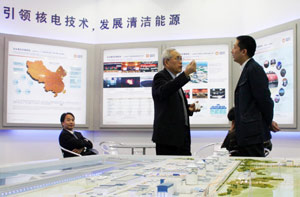China still attractive to FDI
Updated: 2011-10-25 10:40
By Zhang Jianping and Ji Jianjun (China Daily)
|
|||||||||||
Industrial transfer to western regions and growth of service sector will help facilitate the distribution of investments
Statistics show that China has managed to absorb a comparatively large scale of foreign direct investment (FDI) in the first three quarters of this year, despite the turbulent global economic situation.
The value of the country's actual FDI reached $86.68 billion in the first three quarters, equivalent to that of the same period of 2008, but an increase of 16.6 percent year-on-year. However, China's foreign investment growth momentum has also shown signs of slowing down at a time when the global economic recovery still faces a gloomy prospect and the negative influences brought by Europe's sovereign debt crisis are still fermenting.
China's actual foreign investment was $9.05 billion in September, an increase of almost 7.88 percent year-on-year, but in sharp contrast with the average growth rate for the nine months of 16.6 percent. Such a tangible decline means the increased possibility of foreign investment fluctuations in the near future.
Despite the decline in its growth rate, some obvious progress has been achieved in China's FDI structural adjustment. From January to September, the actual foreign investment flowing to the country's manufacturing sector reached $39.97 billion, a meager increase of 1.6 percent, but a year-on-year decline of seven percentage points in the proportion of foreign investment in the country's manufacturing sector. This is partly because developed countries have slowed their pace of outward industrial transfer amid their efforts to regain their lost edge in the manufacturing field.
But compared to the slowdown in the manufacturing sector, actual foreign investment in China's service sector has increased rapidly, reaching $40.19 billion in the first three quarters, an increase of more than 32 percent year-on-year. By the end of September, the proportion of FDI in China's service sector had increased to 45 percent, 5.3 percentage points higher than the previous year. The raised proportion of foreign investment in the country's service sector can mainly be attributed to the central government's policy support for the sector and its efforts to create a favorable environment for foreign investment to play a bigger role. The relevant policies and measures on the outsourcing of the service sector have offered good opportunities for foreign investors.
Although its manufacturing sector has absorbed a large volume of FDI over the past years, China's service sector is becoming an alluring destination for foreign investment because of the potential opportunities.
With the increase in labor costs, China's decades-long cost advantage in attracting foreign investment to its manufacturing has begun to weaken. On the contrary, neighboring countries, such as Vietnam and Thailand are becoming increasingly attractive for foreign investment given their improved investment environment and increased competitiveness in labor costs.
Likewise, compared with its developed eastern regions, China's less-developed central and western regions have attracted increasing foreign investment.
From January to September, the country's western regions absorbed a total of $5.66 billion in actual foreign investment, an increase of almost 49 percent year-on-year, more than 32 percentage points higher than the country's average. As their infrastructure and investment environment continue to improve and their consumption market further expands, the foreign investment in these regions is expected to grow in the future. At the same time, these regions have also demonstrated an increasing attraction for higher-quality labor and intellectuals while also luring cheaper labor. All these factors have helped facilitate the transfer of the country's manufacturing workshops and relevant services from east to west. In particular, the establishment of many national-level economic development zones in the country's western regions, aimed at facilitating such kind of industrial transfer, will inevitably have a positive and interactive influence on the distribution of foreign investment.
As a result of their accelerated economic merger, Asian nations increased their investment in China in the first three quarters. Statistics show that Japan's China-bound investment increased by 60 percent in the nine months of this year. Investment from other countries and regions, such as the Philippines, Thailand, Malaysia, Singapore, the Republic of Korea and China's Hong Kong, Macao and Taiwan regions has also increased by a large margin.
For Japan, its deepened economic dependence on China and its new industrial supply pattern aimed at facilitating post-quake reconstruction have accelerated its pace of industrial transfer to China and increased its investment in existing projects.
Zhang Jianping is director of the Office of International Economic Cooperation under the National Development and Reform Commission and Ji Jianjun is a researcher with the commission's Institute of Foreign Economy.
Related Stories
China's FDI rises 16.6% in Q1-Q3 2011-10-19 10:30
New Yuan FDI scheme unveiled 2011-10-15 07:23
Rules on FDI with RMB settlement issued 2011-10-14 16:46
FDI growth underlines a strong foreign interest 2011-09-16 08:58
- China creates 9.94m new jobs by end of Sept
- JP Morgan confident in its China growth
- CNOOC says oil leaks in Bohai Bay sealed
- Japanese factory workers strike over wage dispute
- BYD sets up North American headquarters in LA
- Resource tax will not affect oil price
- China to simplify foreign exchange rules
- Home prices decline in suburban areas










